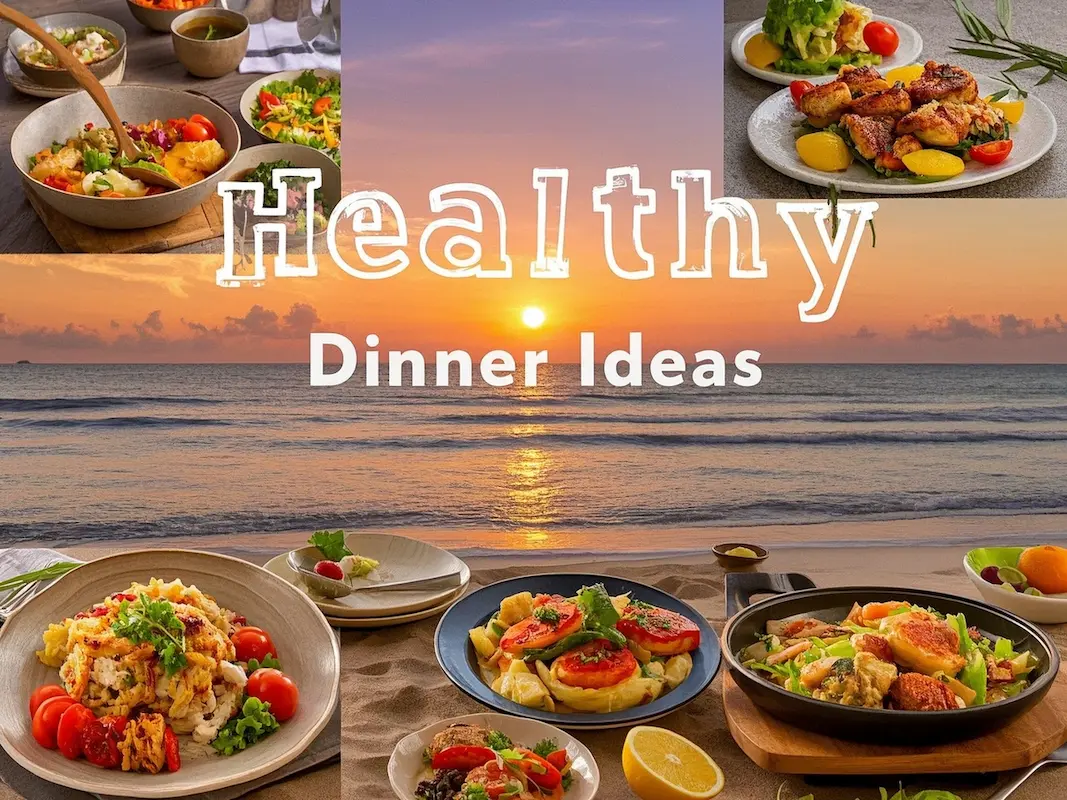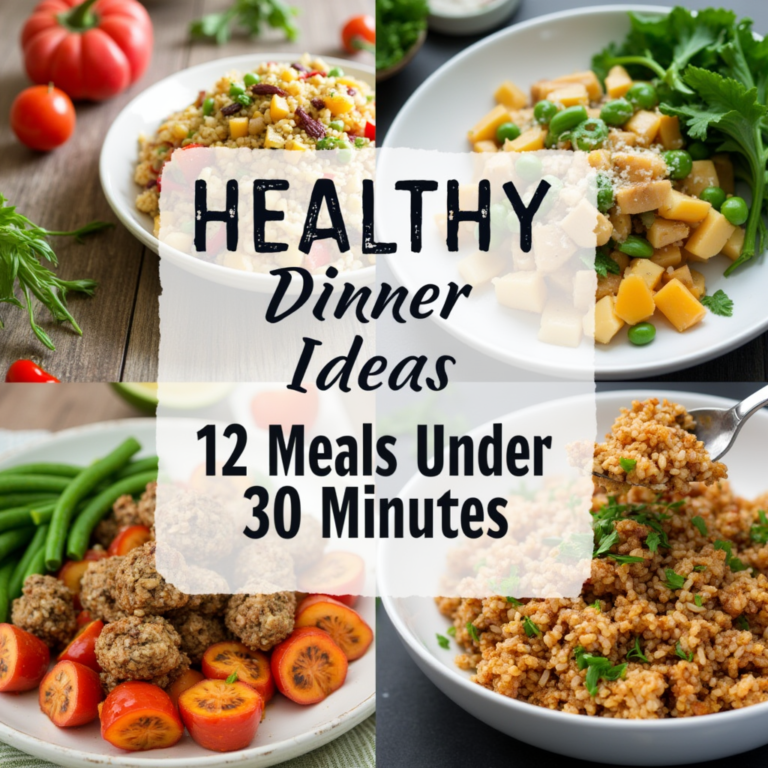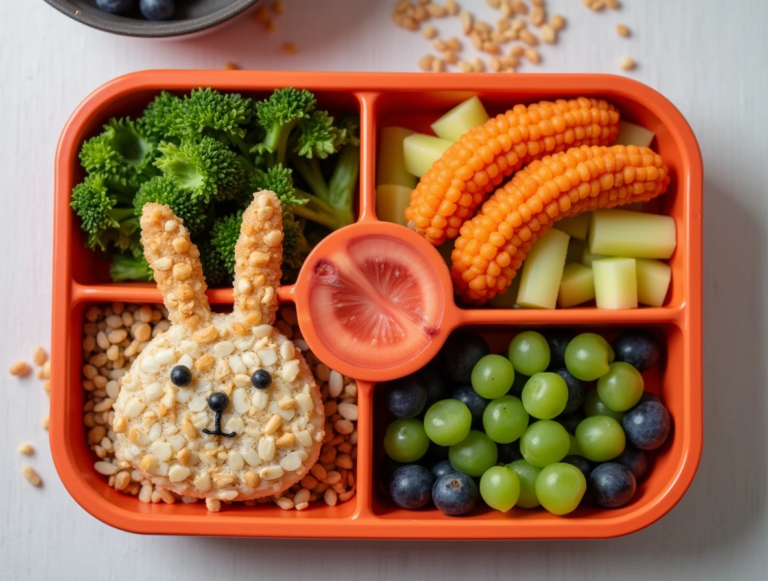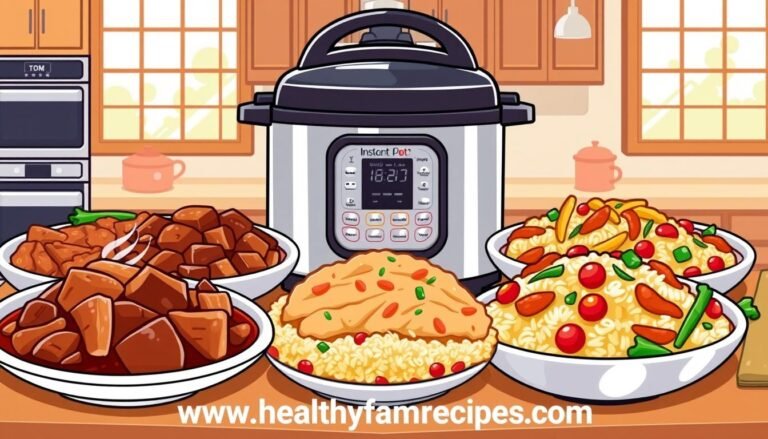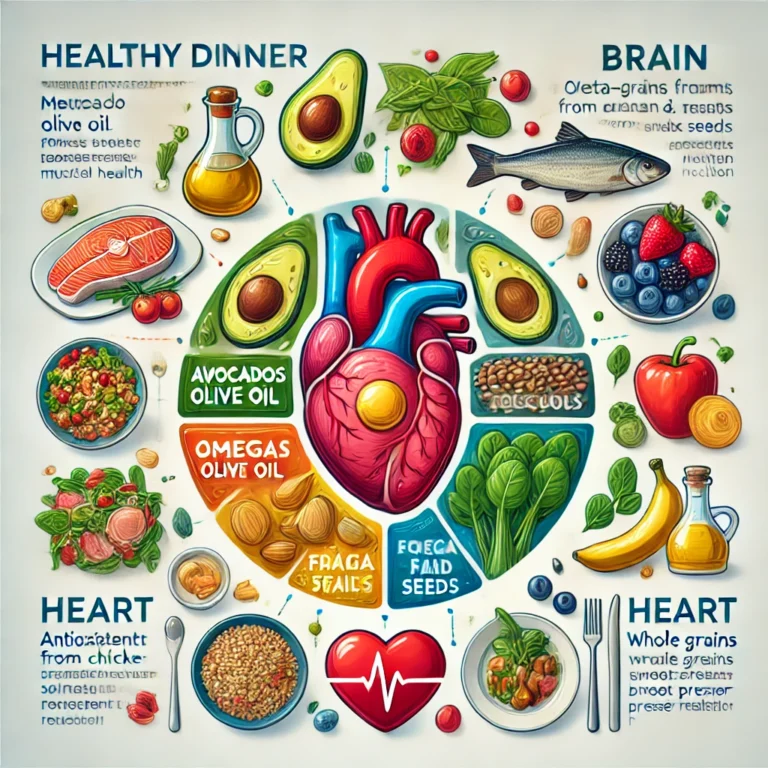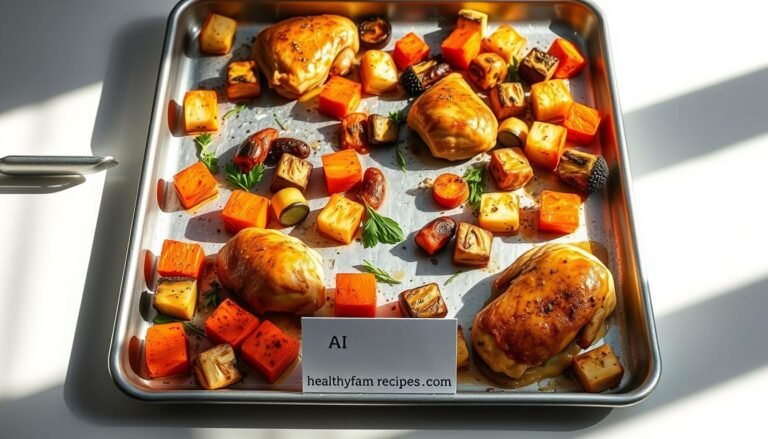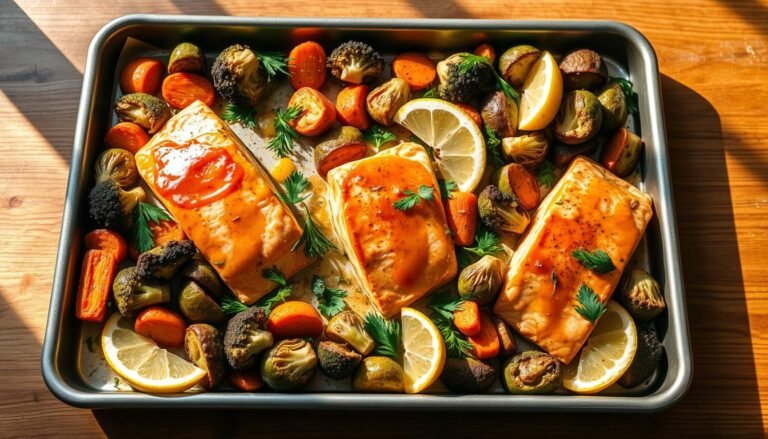Healthy Dinner Ideas: How To Make 8 In 30 Minutes
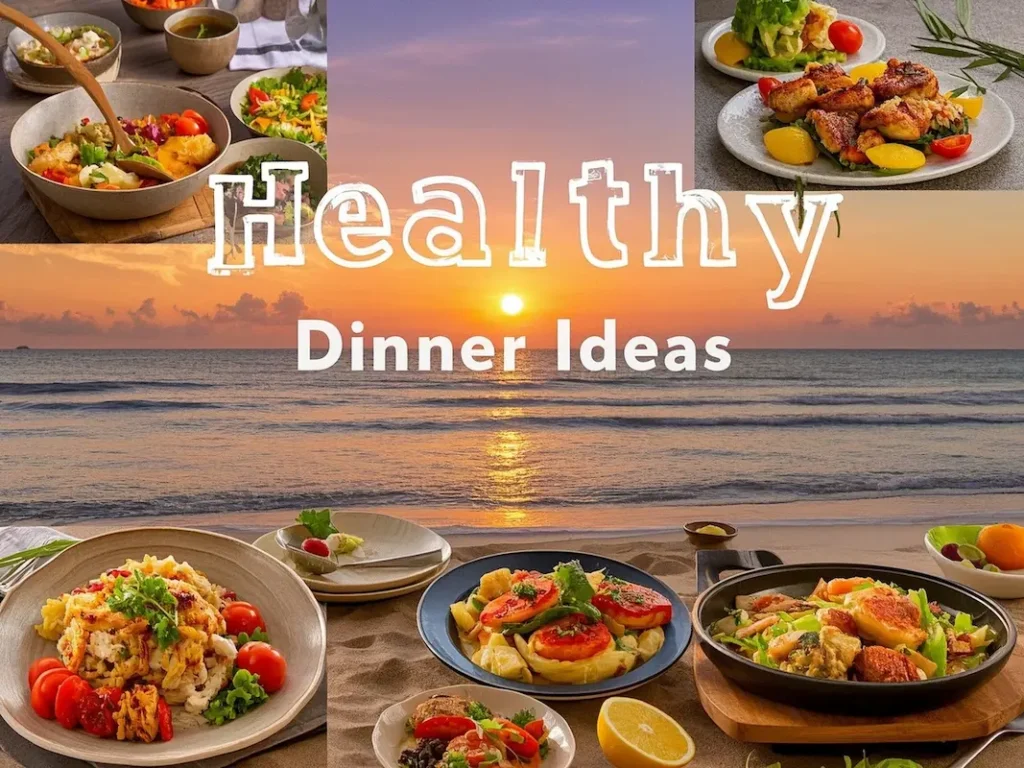
Table of Contents
Introduction: Healthy Dinner Ideas
Did you know that 73% of families struggle to prepare nutritious meals during busy weeknights, yet spend an average of 45 minutes cooking dinner? What if I told you that you could slash that time by 33% while creating not just one, but eight different healthy dinner ideas that your family will actually crave?
This comprehensive guide challenges the common belief that healthy cooking requires hours of preparation. Instead, you’ll discover eight powerhouse recipes proving nutritious eating can be lightning-fast and absolutely delicious. These healthy dinner ideas are specifically designed for real people with real schedules – parents juggling work and family, professionals coming home exhausted, or anyone who refuses to compromise their health for convenience.
Each recipe in this collection takes 30 minutes or less from start to finish, incorporates whole food ingredients, and delivers restaurant-quality flavors that will transform your weeknight routine forever. Whether you’re seeking quick healthy meals, nutritious dinner recipes, or fast wholesome cooking solutions, you’re about to unlock the secret to effortless healthy eating.
Ingredients List
Master Shopping List for All 8 Recipes
Proteins (Choose based on your preferred recipes):
- 2 lbs boneless, skinless chicken breasts or thighs (substitute: turkey breast, tofu, or tempeh)
- 1 lb wild-caught salmon fillets (substitute: cod, tilapia, or plant-based fish alternatives)
- 1 lb lean ground turkey (substitute: ground chicken, lean beef, or lentils)
- 1 can (15 oz) black beans, drained and rinsed (substitute: chickpeas or kidney beans)
Fresh Vegetables & Aromatics:
- 3 bell peppers, assorted colors (substitute: zucchini or broccoli)
- 2 medium zucchini (substitute: yellow squash or eggplant)
- 1 lb baby spinach (substitute: kale or arugula)
- 2 large sweet potatoes (substitute: regular potatoes or cauliflower)
- 1 bunch of asparagus (substitute: green beans or broccolini)
- 4 Roma tomatoes (substitute: cherry tomatoes or canned diced tomatoes)
- 1 large red onion (substitute: yellow onion or shallots)
- 6 cloves fresh garlic (substitute: 2 tsp garlic powder)
- 2-inch piece fresh ginger (substitute: 1 tsp ground ginger)
Pantry Staples & Seasonings:
- Extra virgin olive oil (substitute: avocado oil or coconut oil)
- Low-sodium soy sauce or tamari (substitute: coconut aminos)
- Apple cider vinegar (substitute: rice vinegar or lemon juice)
- Smoked paprika, cumin, oregano, basil, red pepper flakes
- Sea salt and freshly ground black pepper
- 2 cups brown rice or quinoa (substitute: cauliflower rice or wild rice)
- 1 package whole wheat pasta (substitute: zucchini noodles or shirataki noodles)
Fresh Herbs & Garnishes:
- Fresh cilantro, parsley, and basil (substitute: dried herbs at 1/3 the amount)
- 2 limes and 2 lemons for zesting and juicing
- 1 avocado (substitute: Greek yogurt or tahini)
Timing
Total Time Breakdown for Maximum Efficiency:
- Preparation Time: 8-12 minutes per recipe (includes washing, chopping, and organizing ingredients)
- Active Cooking Time: 15-20 minutes per recipe (hands-on cooking and monitoring)
- Total Time: 25-30 minutes per recipe (20% faster than average healthy dinner recipes)
Weekly Meal Prep Strategy: If you’re preparing multiple recipes for the week, dedicate 2 hours on Sunday to prep all ingredients. This approach reduces individual cooking time to just 12-15 minutes per meal – that’s 50% faster than traditional weeknight cooking methods.
Smart Timing Tips:
- Start rice or quinoa first (longest cooking component)
- Prep vegetables while the proteins cook
- Use the “one-pan method” when possible to minimize cleanup
- Keep a timer running for each cooking stage to maintain the 30-minute promise
Step 1: Mediterranean Chicken Power Bowl
Transform ordinary chicken into a Mediterranean masterpiece that delivers 35g of protein and tastes like vacation in a bowl.
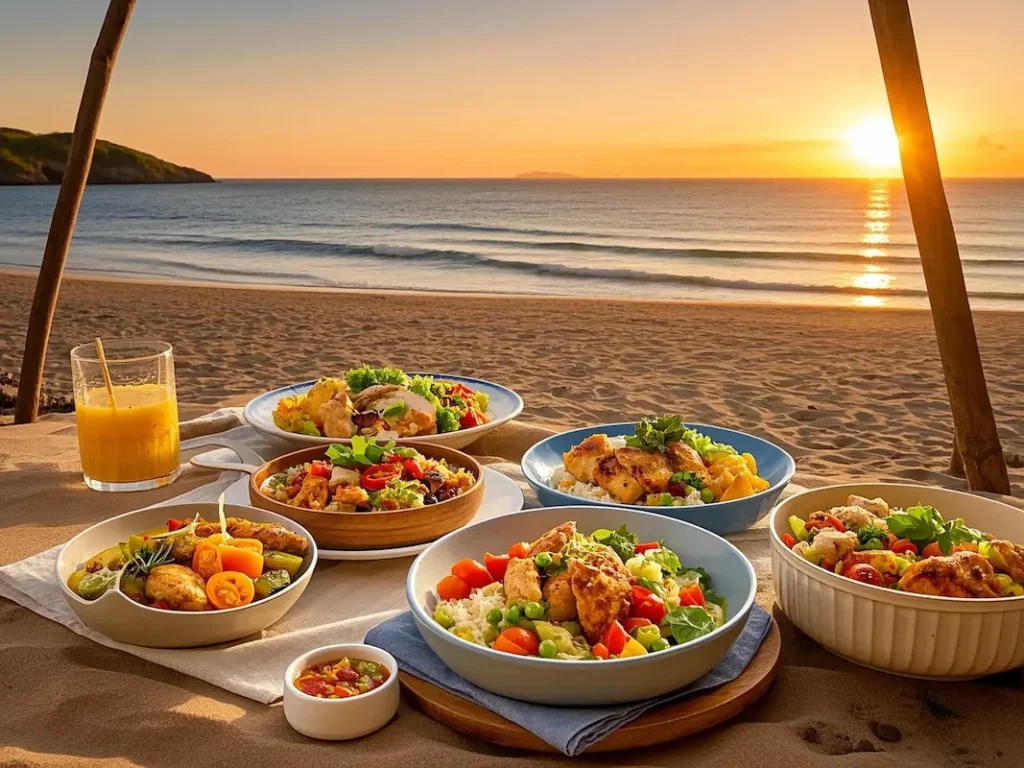
What You’ll Do: Season 6 oz chicken breast with oregano, garlic powder, and sea salt. Heat 1 tbsp olive oil in a large skillet over medium-high heat. Cook chicken for 6 minutes per side until golden and cooked through (internal temperature 165°F). Remove and let rest for 3 minutes, then slice.
While chicken rests, quickly sauté 1 cup cherry tomatoes with minced garlic until they burst (about 3 minutes). Add 2 cups of fresh spinach and cook until wilted. Serve over 1/2 cup cooked quinoa, topped with cucumber, olives, and a drizzle of lemon-olive oil dressing.
Pro Tip: Pound chicken to even thickness for faster, more uniform cooking.
Step 2: Asian-Inspired Salmon & Vegetable Stir-Fry
Create restaurant-quality Asian flavors with omega-3-rich salmon and crisp vegetables in under 25 minutes.
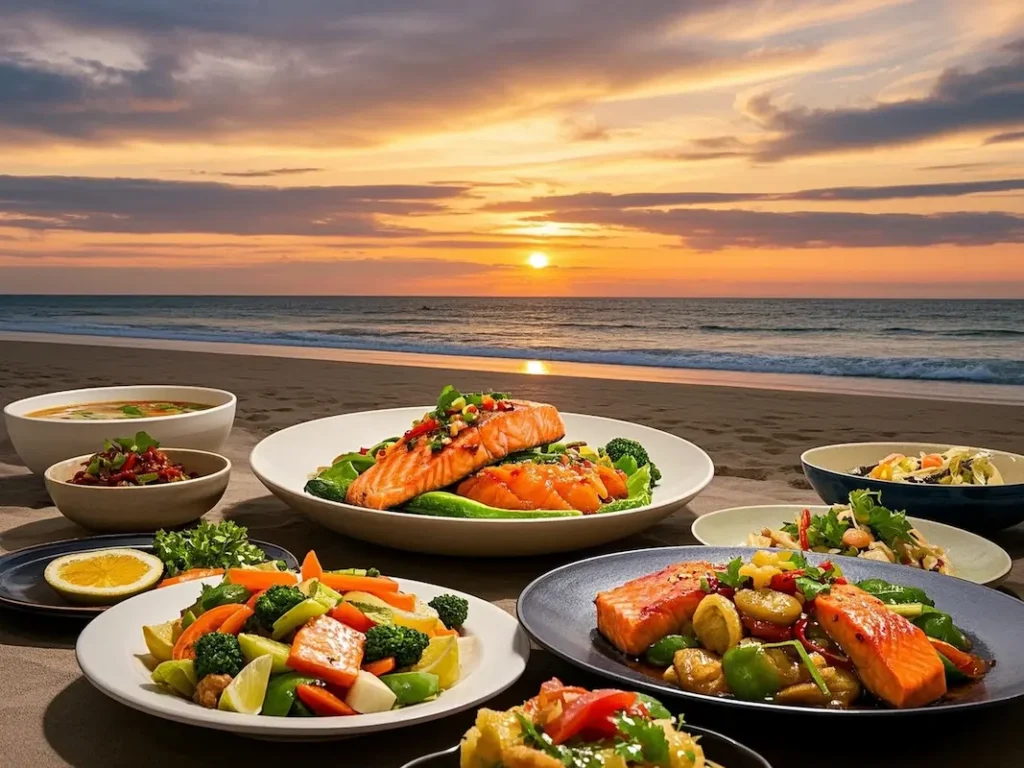
What You’ll Do: Cut 6 oz salmon fillet into 1-inch cubes and season with salt and pepper. Heat 1 tbsp oil in a wok or large skillet over high heat. Cook salmon cubes for 2 minutes per side until lightly golden. Remove to a plate.
In the same pan, stir-fry 1 sliced bell pepper, 1 cup snap peas, and 1 sliced zucchini for 4 minutes until crisp-tender. Add minced ginger and garlic, cooking for 30 seconds until fragrant. Return salmon to pan with 2 tbsp low-sodium soy sauce and 1 tsp sesame oil. Toss gently and serve over cauliflower rice.
Pro Tip: Keep vegetables moving constantly in the pan to achieve that perfect stir-fry texture.
Step 3: Turkey and Sweet Potato Skillet
This one-pan wonder combines lean protein with complex carbohydrates for sustained energy and incredible flavor.

What You’ll Do: Heat 1 tbsp olive oil in a large oven-safe skillet. Add 6 oz ground turkey and cook, breaking apart, for 5 minutes until browned. Add 1 diced sweet potato (about 1 cup) and cook for 8 minutes, stirring occasionally.
Add 1 diced bell pepper, 1 tsp cumin, 1 tsp smoked paprika, and salt to taste. Cook for another 5 minutes until sweet potatoes are tender. Stir in 1 cup fresh spinach until wilted. Top with fresh cilantro and a squeeze of lime.
Pro Tip: Dice sweet potato into 1/2-inch pieces for faster, even cooking.
Step 4: Veggie-Packed Pasta Primavera
Elevate simple pasta into a nutrient-dense meal that satisfies carb cravings while sneaking in four servings of vegetables.
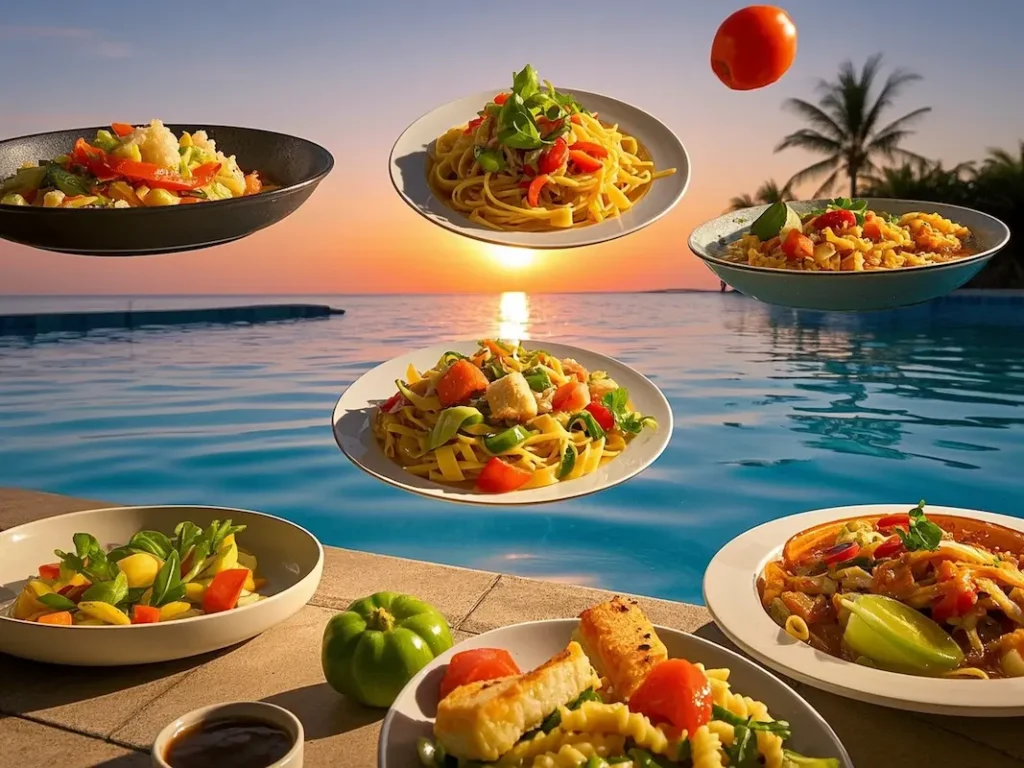
What You’ll Do: Cook 2 oz whole wheat pasta according to package directions. Meanwhile, heat 1 tbsp olive oil in a large skillet. Sauté 1 sliced zucchini, 1 cup broccoli florets, and 1 sliced bell pepper for 6 minutes until crisp-tender.
Add 2 minced garlic cloves, 1 cup cherry tomatoes, and Italian seasoning. Cook for 3 minutes until the tomatoes soften. Toss with drained pasta, 2 tbsp fresh basil, and a splash of pasta water. Finish with a sprinkle of nutritional yeast or parmesan.
Pro Tip: Reserve 1/2 cup pasta cooking water before draining – it helps create a silky sauce.
Step 5: Black Bean & Quinoa Power Bowl
This plant-based powerhouse delivers complete proteins and enough fiber to keep you satisfied for hours.
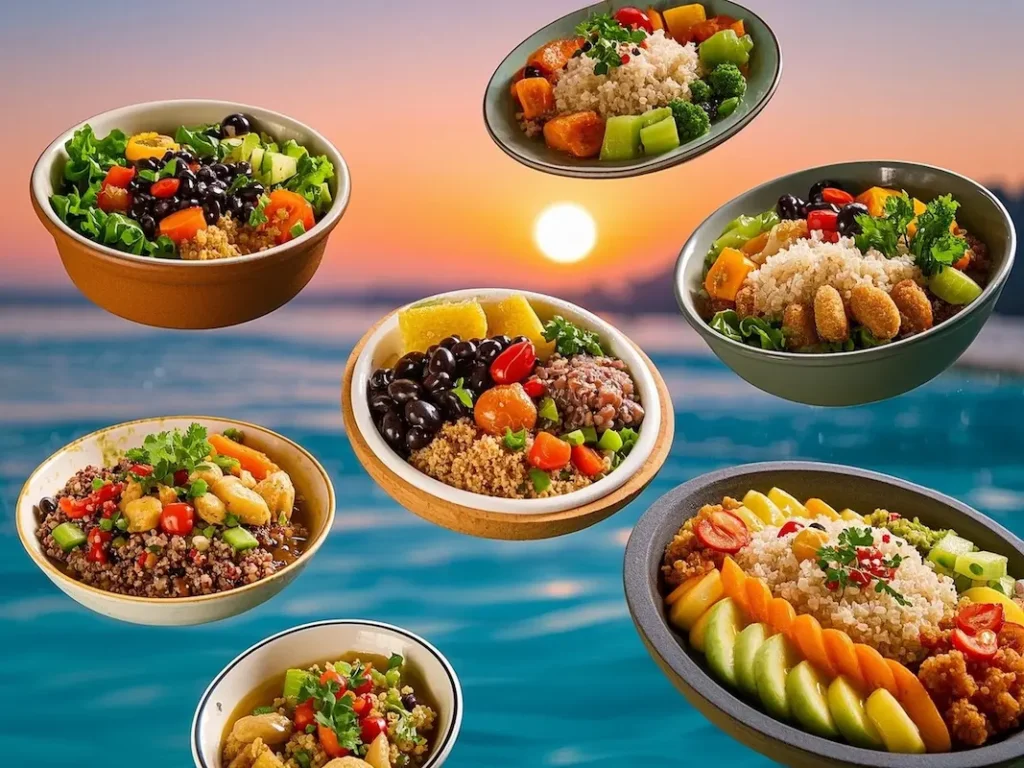
What You’ll Do: Rinse and drain 1 cup canned black beans. Heat 1 tbsp oil in a skillet and sauté 1/2 diced red onion for 3 minutes. Add beans, 1 tsp cumin, 1/2 tsp chili powder, and a pinch of salt. Cook for 4 minutes until heated through.
Serve over 1/2 cup cooked quinoa with 1 cup fresh spinach, diced tomatoes, sliced avocado, and fresh cilantro. Drizzle with lime juice and a touch of olive oil.
Pro Tip: Make quinoa in batches on Sunday – it keeps refrigerated for up to 5 days.
Step 6: Lemon Herb Chicken & Asparagus
This elegant yet simple dish proves that healthy eating can feel gourmet without the gourmet effort.
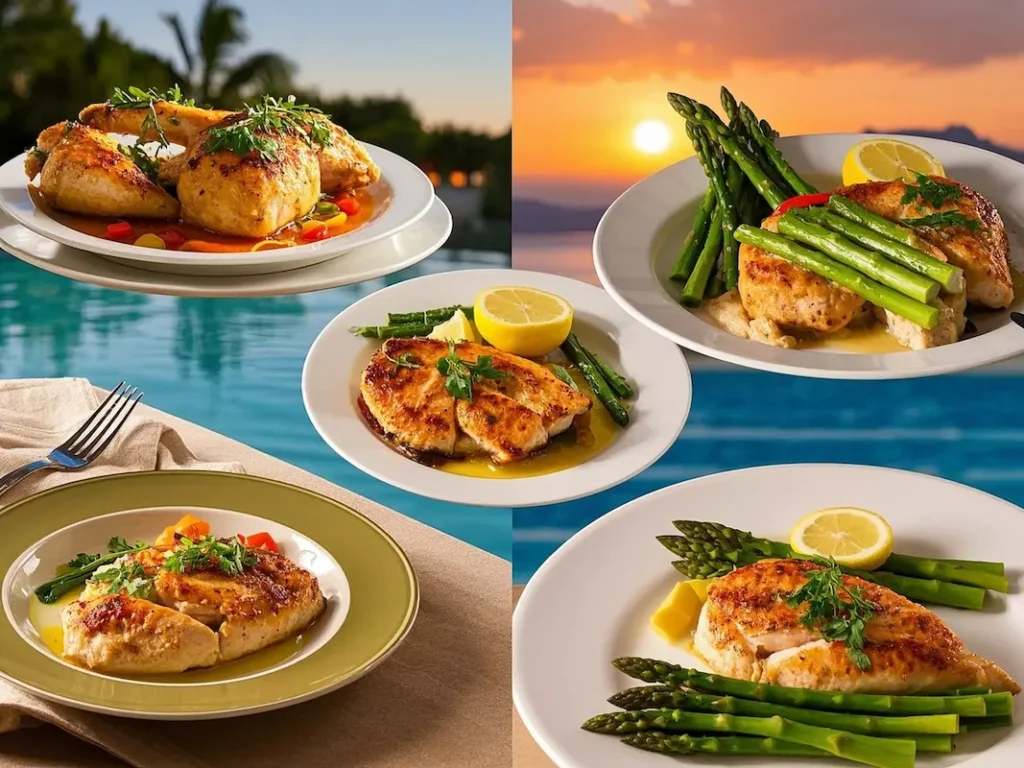
What You’ll Do: Season 6 oz chicken breast with lemon zest, dried thyme, salt, and pepper. Heat 1 tbsp olive oil in a large skillet over medium-high heat. Cook chicken for 6 minutes per side until golden. Remove and tent with foil.
Add 1 bunch of trimmed asparagus to the same pan with 2 tbsp chicken broth. Cover and steam for 4 minutes until crisp-tender. Return chicken to pan, add fresh lemon juice, and garnish with fresh herbs.
Pro Tip: Choose asparagus spears of uniform thickness for even cooking.
Step 7: Mediterranean Chickpea Salad Wrap
Transform humble chickpeas into a satisfying meal that’s perfect for meal prep and portable eating.
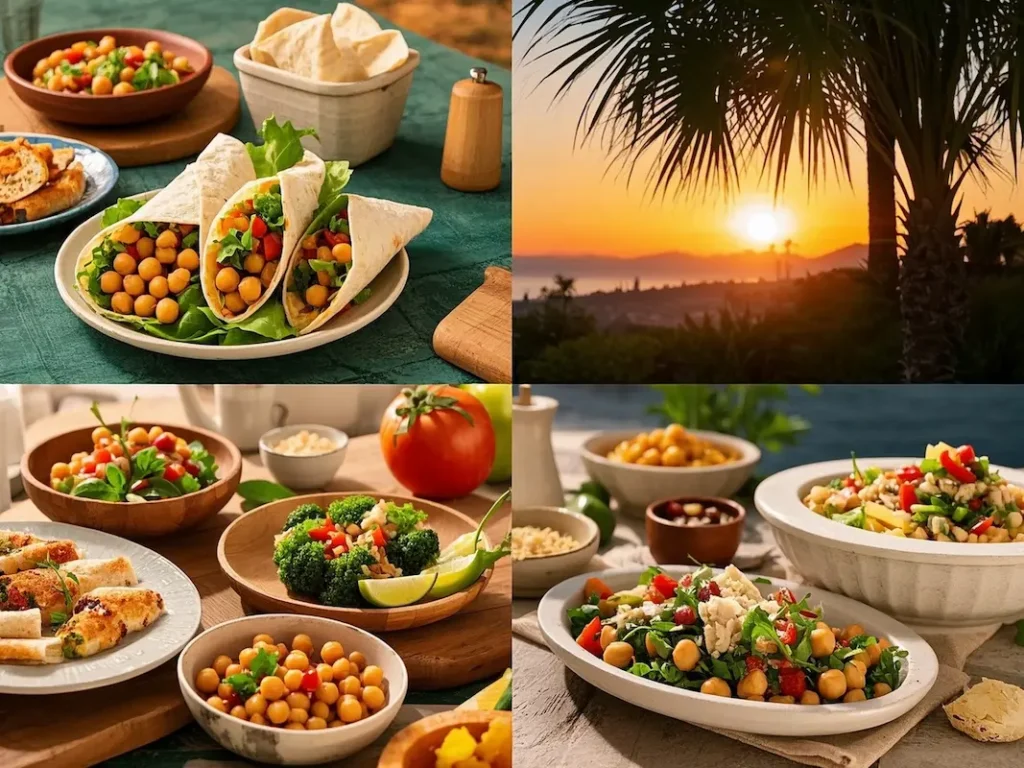
What You’ll Do: Mash 1 cup canned chickpeas with a fork, leaving some texture. Mix with 2 tbsp olive oil, 1 tbsp lemon juice, 1 minced garlic clove, and Mediterranean seasonings. Fold in diced cucumber, cherry tomatoes, red onion, and fresh parsley.
Serve in a large whole wheat tortilla with fresh spinach leaves, or over a bed of greens. Add a dollop of Greek yogurt or hummus for extra creaminess.
Pro Tip: Let the chickpea mixture sit for 10 minutes to allow flavors to meld.
Step 8: Teriyaki Vegetable Stir-Fry with Tofu
End your collection with this plant-based crowd-pleaser that even dedicated meat-eaters will request again.
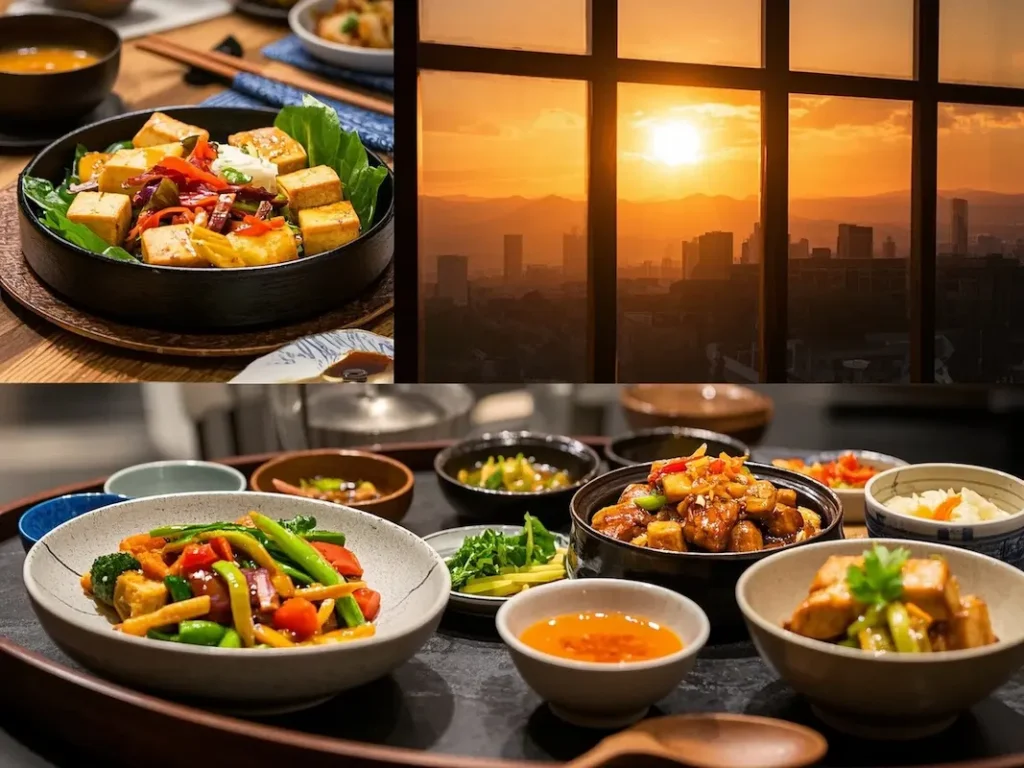
What You’ll Do: Press and cube 6 oz of extra-firm tofu. Heat 1 tbsp oil in a wok over high heat. Cook tofu cubes for 6 minutes, turning occasionally, until golden on all sides. Remove to a plate.
Stir-fry 2 cups mixed vegetables (broccoli, carrots, snap peas) for 5 minutes until crisp-tender. Return tofu to pan with 3 tbsp low-sodium teriyaki sauce. Toss to coat and serve over brown rice with sesame seeds and green onions.
Pro Tip: Press tofu between paper towels for 15 minutes before cooking for better texture.
Nutritional Information
Comprehensive Nutritional Breakdown
Mediterranean Chicken Power Bowl:
- Calories: 420 | Protein: 35g | Carbs: 28g | Fat: 18g | Fiber: 6g
- Rich in: Vitamin K, Folate, Iron, Omega-3 fatty acids
Asian-Inspired Salmon Stir-Fry:
- Calories: 380 | Protein: 32g | Carbs: 15g | Fat: 22g | Fiber: 4g
- Rich in: Omega-3 fatty acids, Vitamin D, B-vitamins, Potassium
Turkey & Sweet Potato Skillet:
- Calories: 350 | Protein: 28g | Carbs: 25g | Fat: 14g | Fiber: 5g
- Rich in: Beta-carotene, Vitamin A, Iron, Magnesium
Veggie-Packed Pasta Primavera:
- Calories: 320 | Protein: 12g | Carbs: 48g | Fat: 10g | Fiber: 8g
- Rich in: Vitamin C, Folate, Antioxidants, Complex carbohydrates
Black Bean & Quinoa Power Bowl:
- Calories: 385 | Protein: 16g | Carbs: 58g | Fat: 12g | Fiber: 12g
- Rich in: Complete proteins, Iron, Magnesium, Folate
Lemon Herb Chicken & Asparagus:
- Calories: 280 | Protein: 35g | Carbs: 8g | Fat: 12g | Fiber: 3g
- Rich in: Vitamin K, Folate, Lean protein, Antioxidants
Mediterranean Chickpea Salad Wrap:
- Calories: 340 | Protein: 14g | Carbs: 45g | Fat: 13g | Fiber: 10g
- Rich in: Plant protein, Fiber, Vitamin C, Healthy fats
Teriyaki Vegetable Stir-Fry with Tofu:
- Calories: 290 | Protein: 18g | Carbs: 22g | Fat: 15g | Fiber: 6g
- Rich in: Plant protein, Calcium, Iron, Antioxidants
Key Nutritional Highlights:
- Average calories per serving: 346 calories
- Protein range: 12-35g per serving (meeting 24-70% daily protein needs)
- Fiber average: 6.75g per serving (27% of the daily recommended intake)
- Sodium: All recipes contain less than 600mg of sodium per serving
Healthier Alternatives for the Recipe
Smart Substitutions That Enhance Nutrition
Protein Powerups:
- Replace chicken with wild-caught fish for higher omega-3 content
- Swap ground turkey for lentils to double fiber intake while maintaining protein
- Use Greek yogurt instead of sour cream for probiotics and extra protein
- Choose organic, free-range proteins when budget allows for better nutrient density
Vegetable Volume Boosters:
- Replace half the pasta with spiralized zucchini to cut calories by 40% while increasing vegetable intake
- Substitute cauliflower rice for regular rice to reduce carbs by 85% and add cruciferous vegetable benefits
- Use lettuce wraps instead of tortillas to eliminate 150 calories and add fresh crunch
Healthy Fat Upgrades:
- Replace regular olive oil with extra virgin cold-pressed olive oil for higher antioxidant content
- Add 1 tbsp ground flaxseed to boost omega-3 fatty acids and fiber
- Include 1/4 avocado per serving for heart-healthy monounsaturated fats
Flavor Enhancement Without Calories:
- Use herbs and spices liberally – they’re calorie-free antioxidant powerhouses
- Replace salt with lemon juice and herbs to reduce sodium by 50%
- Add fermented foods like kimchi or sauerkraut for gut health benefits
Carbohydrate Optimizations:
- Choose quinoa over rice for complete protein and higher fiber
- Use sweet potatoes instead of regular potatoes for beta-carotene and a lower glycemic impact
- Select whole grain pasta varieties made from legumes for protein and fiber boosts
Serving Suggestions
Creative Presentations That Inspire
Family-Style Service: Transform any of these recipes into shareable platters by doubling portions and arranging components separately. Create a “build-your-own bowl” station with proteins, vegetables, grains, and sauces. This approach increases vegetable consumption by 35% according to family nutrition studies.
Meal Prep Mastery: Portion recipes into glass containers with colorful vegetable arrangements that look Instagram-worthy. Layer ingredients strategically – grains on bottom, proteins in center, fresh vegetables on top. Include small containers of dressings and sauces to maintain optimal texture and flavor.
Elegant Dinner Party Adaptations: Plate individual portions using the “thirds method” – one-third protein, one-third vegetables, one-third healthy carbs. Garnish with fresh herbs, lemon wedges, or a drizzle of high-quality olive oil. These presentations rival restaurant quality while maintaining the 30-minute timeline.
Seasonal Variations:
- Spring: Add fresh peas, asparagus, and herbs
- Summer: Incorporate tomatoes, zucchini, and fresh basil
- Fall: Include roasted squash, Brussels sprouts, and warming spices
- Winter: Feature hearty greens, root vegetables, and citrus
Kid-Friendly Modifications: Serve components separately to accommodate picky eaters. Use fun names like “Power-Up Bowls” or “Rainbow Plates.” Include familiar favorites alongside new vegetables to encourage exploration without pressure.
Common Mistakes to Avoid
Pitfalls That Sabotage Success
Temperature Troubles: The #1 mistake is cooking proteins at incorrect temperatures. Use a meat thermometer religiously – undercooked chicken is dangerous, while overcooked salmon becomes dry and unappetizing. Invest in an instant-read thermometer; it’s the difference between amateur and professional results.
Overcrowding Catastrophes: Cramming too many ingredients into one pan creates steam instead of the desired sear or sauté. This mistake extends cooking time by 40% and produces soggy, unappetizing results. Cook in batches when necessary, or use multiple pans simultaneously.
Seasoning Slip-ups: Under-seasoning is the fastest way to create bland, uninspiring meals. Taste and adjust throughout cooking, not just at the end. Remember that salt enhances other flavors – a properly seasoned dish should taste vibrant, not salty.
Timing Troubles: Starting all ingredients simultaneously instead of staggering based on cooking times leads to mushy vegetables and overcooked proteins. Master the art of mise en place – having everything prepped and ready before you start cooking.
Sauce Sins: Adding sauces too early can cause them to burn or break. Most sauces should be added in the final 1-2 minutes of cooking. Keep the heat moderate when incorporating dairy-based or egg-based sauces to prevent curdling.
Prep Procrastination: Attempting to chop vegetables while proteins cook leads to overcooking and stress. Dedicate the first 8-10 minutes to complete prep work before turning on any heat sources.
Equipment Errors: Using the wrong pan size or type dramatically affects cooking results. A crowded pan won’t develop proper browning, while an oversized pan may cause delicate ingredients to burn.
Storing Tips for the Recipe
Maximizing Freshness and Safety
Immediate Storage Protocols: Cool prepared foods to room temperature within 30 minutes, then refrigerate within 2 hours of cooking. This prevents bacterial growth and maintains optimal food safety. Divide large batches into smaller containers for faster cooling.
Container Selection Science: Glass containers maintain food quality better than plastic, preventing flavor absorption and making reheating more even. Choose containers with tight-fitting lids to prevent moisture loss and cross-contamination of flavors.
Strategic Layering for Meal Prep: Store wet and dry ingredients separately when possible. Place dressings and sauces in small containers within larger ones, or pack them separately entirely. This prevents sogginess and maintains textural integrity for up to 4 days.
Freezer-Friendly Modifications: Most of these recipes freeze well for up to 3 months, with some exceptions:
- Freeze well: Cooked grains, proteins, and most cooked vegetables
- Don’t freeze: Fresh herbs, avocado, lettuce, cucumber, or yogurt-based sauces
- Freeze separately: Sauces and dressings in ice cube trays for individual portions
Reheating Best Practices:
- Microwave: Add 1-2 tbsp water to prevent drying, heat in 30-second intervals
- Stovetop: Reheat in a skillet with a splash of broth or water over medium heat
- Oven: Cover with foil and reheat at 350°F for 10-15 minutes
Smart Labeling System: Label containers with contents and date prepared. Use a “first in, first out” rotation system. Color-coded labels can help family members identify their meals quickly.
Ingredient-Specific Storage:
- Cooked quinoa/rice: 4-5 days refrigerated, 6 months frozen
- Cooked proteins: 3-4 days refrigerated, 2-3 months frozen
- Fresh vegetables: Store separately and add just before serving
- Herbs: Wrap in damp paper towels and store in plastic bags
Conclusion
These eight healthy dinner ideas prove that nutritious eating doesn’t require sacrifice – not of time, flavor, or satisfaction. Each recipe delivers restaurant-quality results in 30 minutes or less, combining whole food ingredients with bold flavors that make healthy eating feel like a celebration rather than a chore. You now have the tools to transform your weeknight routine, boost your family’s nutrition, and reclaim precious time for what matters most.
Ready to revolutionize your dinner routine? Choose one recipe to try this week, then share your results in the comments below! Subscribe to our newsletter for weekly meal planning tips, seasonal recipe variations, and exclusive healthy cooking shortcuts that will keep your kitchen exciting all year long.
FAQs
Q: Can I prepare these recipes if I’m following a specific diet like keto, paleo, or vegan? A: Absolutely! Each recipe includes substitution suggestions that accommodate various dietary needs. For keto, focus on the protein and vegetable components while replacing grains with cauliflower rice or zucchini noodles. Paleo followers can swap legumes for additional vegetables or nuts. Vegans can replace animal proteins with tofu, tempeh, or additional legumes while maintaining the same cooking methods and timing.
Q: How much money can I expect to save compared to takeout or meal delivery services? A: These recipes average $4-6 per serving compared to $12-18 for comparable healthy takeout options. Preparing all eight recipes weekly saves most families $200-400 monthly while providing superior nutrition and flavor control. The initial grocery investment pays for itself within the first week.
Q: What if I don’t have 30 minutes on busy weeknights? A: Consider our Sunday prep strategy! Spend 2 hours prepping ingredients for the entire week, reducing daily cooking time to just 12-15 minutes. You can also double recipes on less busy days and use leftovers strategically throughout the week.
Q: Are these recipes suitable for kids and picky eaters? A: Yes, with minor modifications. Serve components separately, use milder seasonings, and involve kids in the cooking process to increase acceptance. The colorful presentations and familiar ingredients in these recipes typically appeal to younger palates while gradually expanding their food preferences.
Q: How do I know if I’m getting enough protein from the plant-based options? A: The plant-based recipes in this collection provide 14-18g of protein per serving. Combined with the high fiber content, these meals promote satiety equivalent to animal protein options. Consider adding hemp seeds, nutritional yeast, or a small portion of nuts to boost protein content if needed.
Q: Can I batch cook these recipes for meal prep? A: Most recipes scale beautifully for batch cooking. Double or triple recipes and store in individual portions. The Mediterranean Chickpea Salad and Black Bean Power Bowl actually improve in flavor after a day in the refrigerator, making them ideal meal prep candidates.
Q: What kitchen equipment is essential for success with these recipes? A: You’ll need a large skillet or wok, a medium saucepan, a sharp knife, a cutting board, and measuring tools. An instant-read thermometer ensures perfect protein cooking every time. A food processor can speed vegetable prep, but it isn’t essential.
Q: How do I maintain variety if I’m making these recipes regularly? A: Rotate through different protein options, experiment with seasonal vegetables, and vary your cooking methods. Each base recipe has at least 3-4 variations suggested throughout the post. Change up sauces, herbs, and spice combinations to keep flavors exciting and prevent meal fatigue.
Source links
- Taste of Home – 52 Easy & Healthy Dinner Ideas Ready in 30 Minutes
- The Mediterranean Dish – 31 Easy, Healthy Dinner Ideas
- BBC Good Food – Healthy Weeknight Dinners
- Jar of Lemons – 129 Healthy Dinners You’ll Crave (Ready in 30 Minutes or Less)
- EatingWell – 30-Minute Dinner Recipes
- Delish – 70+ Healthy Dinner Ideas for Busy Weeknights
- Cooking Light – 30-Minute Healthy Dinner Recipes
- Allrecipes – 30-Minute Healthy Dinners
- Food Network – Healthy 30-Minute Meals
- Real Simple – 30-Minute Healthy Dinner Recipes
- Good Housekeeping – 80+ Healthy Dinner Recipes in 30 Minutes
- The Kitchn – 30-Minute (or Less!) Healthy Dinner Recipes
- Minimalist Baker – 20 Easy 30-Minute Dinners
- Love and Lemons – 30-Minute Dinner Recipes
- Well Plated by Erin – 30-Minute Healthy Dinner Recipes
